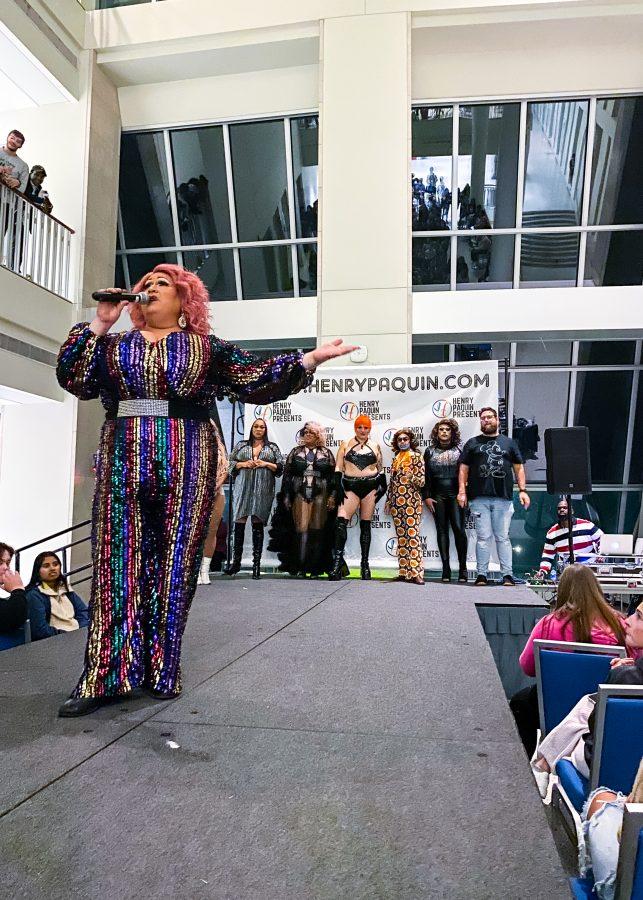“If you can’t love yourself, how the hell are you gonna love somebody else,” said RuPaul, an American drag queen, television judge, musician and model. RuPaul is also known for his show, “RuPaul’s Drag Race,” a competition-based show for drag queens, which is streaming on Paramount+, AppleTV and Hulu.
UMass Boston’s very own Queer Student Center took inspiration from this show and hosted their own kickoff event—a drag night on Sept. 29.
Drag is a style of gender-bending art in which performers dress in accessories and makeup that over-emphasize certain features of gender identity. Drag has historically served as a sort of entertainment and performance, but it is now employed as a means of self-expression and a way to celebrate LGBTQ+ pride. Lip-syncing and dancing are frequently used in drag performances, and the performers often sport lavish outfits, hairstyles and cosmetics.
Students were buzzing with excitement at the event, and the Campus Center was utterly packed. It was a full house, and spectators even trekked to the second and third floor balconies to get a view of the show. Before the main event started, audience members were given the chance to line up on stage, take pictures and talk to the performers. The anticipation built as the show grew closer, and the audience was not disappointed.
The show had six drag queens and one drag king. It started with the announcer introducing each performer separately, and one by one, they hyped up the audience with a small dance number. After this warm-up, the drag queens and king individually performed two songs each, back-to-back, before it was time for intermission.
During intermission, seven students were invited up to try their own hand at drag. They were asked to walk and dance to a song to showcase their personal style. Some performed confidently as the audience cheered them on, and others were—understandably—a little more nervous. This provided the drag queens and king an opportunity to change into their next jaw-dropping outfits. The clothes screamed drag in every possible way: Colorful, glittery and extra.
The performers had three to four outfit changes throughout the show and performed individually again after intermission. After their final dances, the performers waved goodbye in an exciting finale where they hyped up the audience one last time.
UMass Boston sophomore, Pari Vachhani, who attended the event, said, “The drag show was one of a kind, partly because it was my first ever experience watching it live, and secondly, it was on campus. I was so excited to see the Campus Center terrace area fully packed, and the energy was infectious. Students were cheering and hooting for the performers, and I had a blast. I am sure other students will echo my experience.”
Tipping was expected during the performances. Some students venmo-ed the drag queens and king their tips, but many handed them cash on stage—as well as slipping it into other places. A small tip, whether it be $1 or $5, went a long way, and the students got to connect with the artists through these interactions that entertained the whole audience. Furthermore, performers frequently interacted with those closest to them, enticing students to dance, smile and sing along with them.
In an interview with Kris Knievil—one of the drag queens—Knievil spoke about where their beginnings in drag took place and what it means to them now.
“It all started when I was in college, and I was dared to perform in a theater contest. Now it’s 25 years of me performing and loving what I do. Putting on all this makeup and a mask makes me more confident and adventurous,” said Knievil.
Knievil also spoke about the change in society’s attitude toward drag, explaining that communities are more “positive and accepting” than they once were. Knievil believes this shift “is empowering and will inspire new people to join.”
Overall, this was a spectacular startup for the Queer Student Center, and many are dying to see what they have in store next!
‘The Q’ brings drag to UMass Boston
A highlight from the drag show on Thursday, Sept. 29, 2022. Photo by Vansh Khokhani / Mass Media Staff
About the Writer
Vansh Khokhani, Arts Writer

